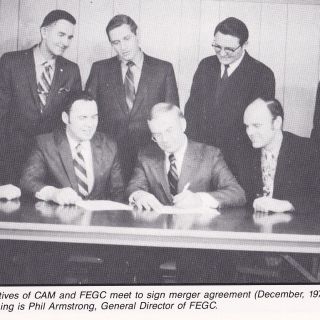
The Merger
The unfortunate trend within the church is to split when the going gets tough, even though our goal is the same; to make disciples. We are blessed to know that God can bring different cultures together to advance His Kingdom. We know this because this is the story of SEND North’s relationship to SEND International. We used to be two separate organizations, but God brought us together through an extraordinary merger!
SEND North was born as Central Alaska Mission (CAM) by a man with a vision. Vince Joy, pilot, and preacher, and his family established this vital village ministry in Alaska in 1937. CAM was comprised of four programs: village ministry, Cross Roads Medical Center (1956), KCAM Christian Radio (1964), and Alaska Bible College (1966). At Vince Joy’s death in 1966, his legacy at CAM was carried on by the Board of Directors.
The Board struggled with growing the ministry due to the technicalities of legal, financial, and staffing challenges. This was when they met Phil Armstrong, Director of the Far Eastern Gospel Crusade (FEGC). FEGC was a semi-large organization started by WWII veterans in Japan and the surrounding area, who saw the devastation of the war and the need for God within the local people they encountered. After much prayer and discussion, SEND International was born through the merger of CAM with FEGC in 1971. This pairing provided help and guidance with the ministries in Alaska and set the stage for God to continue to expand these ministries across the globe.
Let us be honest at this point, the unity between the Asia-based and the rural Alaska-based ministry was geographically perplexing, but the two organizations understood their need for one another. While the locations, cultures, and values between the two areas were very different, the goals of both organizations, as well as the characteristics of these areas, were somewhat similar. Both groups sought to spread the Gospel to the indigenous regions within their reach. Both encountered language and cultural barriers as well. Finally, both organizations had the drive for church-planting and building relationships. This pattern of bringing cultures together to minister has repeated itself many times over as SEND International opened ‘fields’ in Europe, Russia, and Asia. SEND North is one of those ‘fields,’ making disciple-makers in Alaska and Northern Canada.
SEND International still uses these same bonds to unify the vastness of their ministry locations as well as the diverse cultures represented within local, multi-cultural teams. By seeking to use each person’s strengths, engaging with the culture, seeking out open hearts, and committing to areas for the long haul, SEND International and SEND North to continue to work as one for the advancement of the Gospel.
Additional Posts




